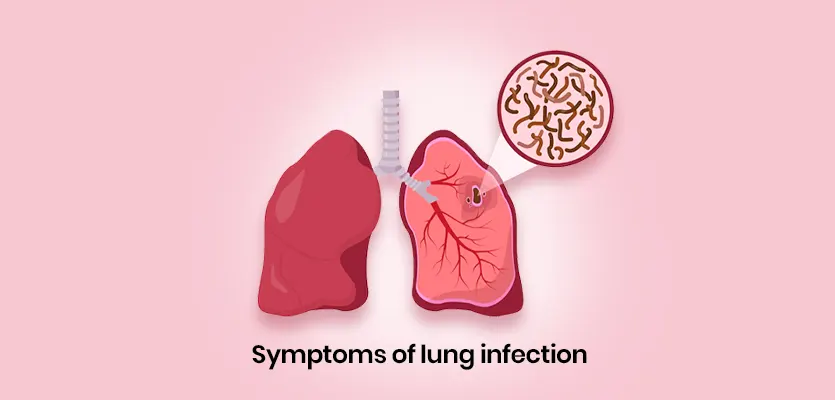Infections of the lungs can manifest a variety of symptoms. A lung infection initiates with an upper respiratory tract infection that gets deep into the bronchioles, the pulmonary air sacs, or the alveoli.
The causes of lung infection are mainly attributed to bacteria and viruses. However, certain fungus forms also can infect the lungs. The most common type of lung infection is pneumonia, which affects the minute and the deep air sacs.
A person with pneumonia is likely to have a chronic cough, cold, wheezing, and breathing difficulty, with a lot of phlegm and infection stuffy in the lungs. This article explores the significant symptoms that anyone should not avoid as they can indicate an acute lung infection.
How do the lungs get infected?
A person usually catches a lung infection by breathing in infectious viruses and bacteria. Initially, these contagious pathogens enter the bronchi with the air and affect the bronchial tubes. This type of infection is referred to as bronchitis.
Bronchitis is a typical virus-borne infection that can penetrate the deep air passages and lungs. This advanced infection is called bronchiolitis. Viral bronchiolitis is common among infants.
When the infections affect the lungs, it leads to pneumonia. Early-stage pneumonia is typically mild and can be treated with an early diagnosis. However, a more severe form of pneumonia is common in people with compromised immunity or chronic health conditions, such as chronic obstructive pulmonary disease (COPD).
Knowing the initial symptoms of lung infection, and diagnosing and treating them early, can prevent its chronic progression.
Signs and symptoms of lung infection you should not ignore
The lung infection symptoms can be mild or severe and vary depending on various factors, including age and health condition. Infections of the lungs due to viruses, bacteria, or fungi can lead to symptoms similar to the flu or common cold. However, these symptoms can stay for a long time, paving the way for a progressive, long-term infection. Symptoms of lung infection that should never be avoided.
Here are some common, underlined symptoms you can expect during an ongoing lung infection.
Persistent coughing with thick mucus
Infection of the lungs and air passages causes inflammation or swelling that can lead to constant mucus formation. One instantly coughs in the process of getting rid of the mucus generated.
In a person with bronchitis and pneumonia, coughing releases a thick mucus that may have a distinct colour like white, green, yellowish-green, or even clear mucus. Coughing in cases of severe bronchitis can stay for several weeks, even after the symptoms get alleviated.
Chronic pain in the Chest
Chest pain is highly common among people with cough and cold. This can be due to coughing and inflammation of the airways.
In cases of pneumonia, chest pain can be sharp, stabbing, and worsen while coughing or breathing. The pain can even radiate to the back or upper back.
Fever
The body temperature tends to rise from its optimal levels of 98.6°F (37°C) when the body is fighting an infection.
During a bacterial, viral, or fungal lung infection, one may have a fever as high as 105°F (40.5°C). And anyone having a fever beyond 102°F (38.9°C) will have symptoms, such as:
- Chills,
- Sweating,
- Muscle aches or soreness,
- Dehydration,
- Weakness,
- Headaches, and
- Body aches.
You may need to see a doctor if you have a fever above 102°F (38.9°C) and if a high fever stays for more than three days.
Body aches
The muscles tend to become weak and sore during lung infection. And one may constantly have chest and back pain called myalgia. This is because the muscles develop swelling or inflammation during the lung infection, causing body aches even when the muscles are at rest.
Stuffy or runny nose
The nasal passages often get stuffed with mucus or phlegm during bronchitis. This can lead to a stuffy or runny nose that starts with flu-like symptoms- sneezing, headaches, and nasal irritation.
Breathing difficulty
Difficulty in breathing can cause shortness of breath and incomplete or heavy breathing. You will need to seek immediate medical attention if you have trouble breathing.
Fatigue or weakness
An infection, especially a chest infection, can make one feel sluggish or weak. It is crucial to rest while your body is fighting the infection.
Wheezing
Wheezing is when the exhaling activity while breathing produces a whistling, hissing, or heavy sound. This can be due to constricted airways and inflammation. Prolonged wheezing will require you to see a doctor and have a thorough checkup to check for asthmatic or allergic symptoms or to rule out a lung infection.
Bluish colouration of the skin or lips
During a lung infection or bronchitis, the inflammation and narrowing of air passages can lead to low oxygen intake by the blood. This lack of optimum oxygen levels in the blood can lead to a palish blue colouration of the skin and nails.
Crackling sounds at the base of the lungs
The base of the lungs is the deeply affected region that can give out crackling or rattling sounds, also called bibasilar crackles. These are one of the signs of lung infection that a doctor can make out through a stethoscope examination.
Take Away
A lung infections symptoms are similar to a common cold or flu but are more severe and can last long.
During lung infection, your body typically fights to ward off infections. But, when the immune system is weak or compromised, lung infections can aggravate, causing critical pneumonia conditions.
And so, if you have one or more symptoms of lung infections, you must see a doctor for immediate medical help and treatment.
Not to forget that people above 65 and infants below 2 years have a high risk of developing lung infection and need to be immediately addressed if they have any of the above-mentioned clinical manifestations.
FAQs
How do you know if a lung infection is serious or not?
According to the Mayo Clinic, it is paramount to see a doctor if you have
- Trouble breathing,
- Fever above 102°F (38.9°C) for more than three days, and
- Persistent cough with mucus.
What happens if a lung infection is left untreated?
If your lung infection is untreated, the pleural layer covering the lungs and chest wall can get swollen, causing sharp pain while breathing. Sometimes, the pleural can get filled with fluid, causing pleural effusion and worsening lung infection and pus formation.
What causes lung infection?
Bronchitis, pneumonia, and bronchiolitis are three lung infection types typically caused by bacteria, viruses, or fungi.
Common microorganisms causing bronchitis and pneumonia include viruses, such as the influenza virus or respiratory syncytial virus (RSV), and bacteria, such as Mycoplasma pneumoniae, Chlamydia pneumoniae, Bordetella pertussis, Streptococcus pneumonia, Haemophilus influenzae.
Rarely do fungi, such as Pneumocystis jirovecii, Aspergillus, or Histoplasma capsulatum, contribute to lung infections.

.webp)



